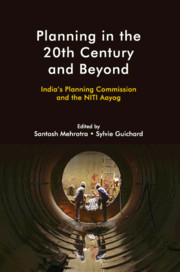Book contents
- Frontmatter
- Contents
- List of Figures
- List of Tables
- List of Abbreviations
- 1 Planning for a 21st Century India
- Part I Origins: Ideas and Ideology
- 2 From Economists to Historians: Studying the Planning Commission, 1950–2014
- 3 The Long Road to Indian Economic Planning (until 1950)
- 4 Ideas and Origins of the Planning Commission in India
- Part II Changes and Continuity: Development and Adaptation of Planning and the Planning Commission
- 5 The Planning Commission and Education
- 6 Addressing Agrarian Distress: Sops versus Development
- 7 Economic Planning after Economic Liberalization: Between Planning Commission and Think Tank NITI, 1991–2015
- 8 Planning Commission: Obiter Dictum
- 9 On a Revived Planning Commission
- Part III Planning Beyond the Planning Commission
- 10 Make in India
- 11 Manufacturing: The Cornerstone of a Planning Strategy for the 21st Century
- 12 Fiscal Planning to Sustain Growth and Poverty Reduction
- 13 Plan, but Do Not Over-plan: Lessons for NITI Aayog
- 14 Why Does India Need a Central Planning Institution in the 21st Century?
- Notes on Contributors
- Index
- References
2 - From Economists to Historians: Studying the Planning Commission, 1950–2014
Published online by Cambridge University Press: 04 April 2020
- Frontmatter
- Contents
- List of Figures
- List of Tables
- List of Abbreviations
- 1 Planning for a 21st Century India
- Part I Origins: Ideas and Ideology
- 2 From Economists to Historians: Studying the Planning Commission, 1950–2014
- 3 The Long Road to Indian Economic Planning (until 1950)
- 4 Ideas and Origins of the Planning Commission in India
- Part II Changes and Continuity: Development and Adaptation of Planning and the Planning Commission
- 5 The Planning Commission and Education
- 6 Addressing Agrarian Distress: Sops versus Development
- 7 Economic Planning after Economic Liberalization: Between Planning Commission and Think Tank NITI, 1991–2015
- 8 Planning Commission: Obiter Dictum
- 9 On a Revived Planning Commission
- Part III Planning Beyond the Planning Commission
- 10 Make in India
- 11 Manufacturing: The Cornerstone of a Planning Strategy for the 21st Century
- 12 Fiscal Planning to Sustain Growth and Poverty Reduction
- 13 Plan, but Do Not Over-plan: Lessons for NITI Aayog
- 14 Why Does India Need a Central Planning Institution in the 21st Century?
- Notes on Contributors
- Index
- References
Summary
Introduction
How has the Planning Commission (PC) been studied from its foundation in 1951 until its dissolution in 2014? The aim of this chapter is not to be exhaustive but rather to be able to draw some trends in the way researchers have looked at this institution. This travel into the literature led me to four observations that I present as starting point:
1. Researchers have devoted a lot of attention to planning and to the five-year plans (FYPs) but the PC as an institution has been little studied (even if this is changing).
2. The PC has been ‘questioned’ differently over time by scholars from various disciplines, notably economics, development studies, and history. Moreover, these scholars followed different theoretical trends, and consequently, they looked in different ways at the PC.
3. Studies on planning often speak about development planning but they consider mainly industrial planning. Some attention is devoted to agriculture but very little is said about most of the other divisions which compose the PC. On its archived version, the website of the PC enumerates the 31 divisions that composed the PC (PC 2014).
4. There have been several recurring criticisms over the 65 years of life of the PC (of course, the liberal critique of planning but also – among others – the necessity to decentralize planning).
This chapter is composed of a shorter section I, which presents my first observation. Section II, the more substantial, develops in five sub-sections, the second observation through a chronological review of some of the vast literature on planning and the PC. The third observation is deduced from my reading presented in this second part, but it will not be examined on its own. The conclusion briefly sketches the fourth observation.
The PC as an Institution
For me as a political scientist working on contemporary India, the work of the PC was quite mysterious. I was aware that it was ‘out there’, I assumed that it was powerful, but it was unclear how. What did it do exactly? How did it work? When I tried to know more about it, I could find a lot about the first FYPs, frequent mentions of the content of subsequent plans but only very brief mentions of the commission per se. Most books are very quick on how the commission was working and often completely mute on who was peopling it.
- Type
- Chapter
- Information
- Planning in the 20th Century and BeyondIndia's Planning Commission and the NITI Aayog, pp. 23 - 42Publisher: Cambridge University PressPrint publication year: 2020



